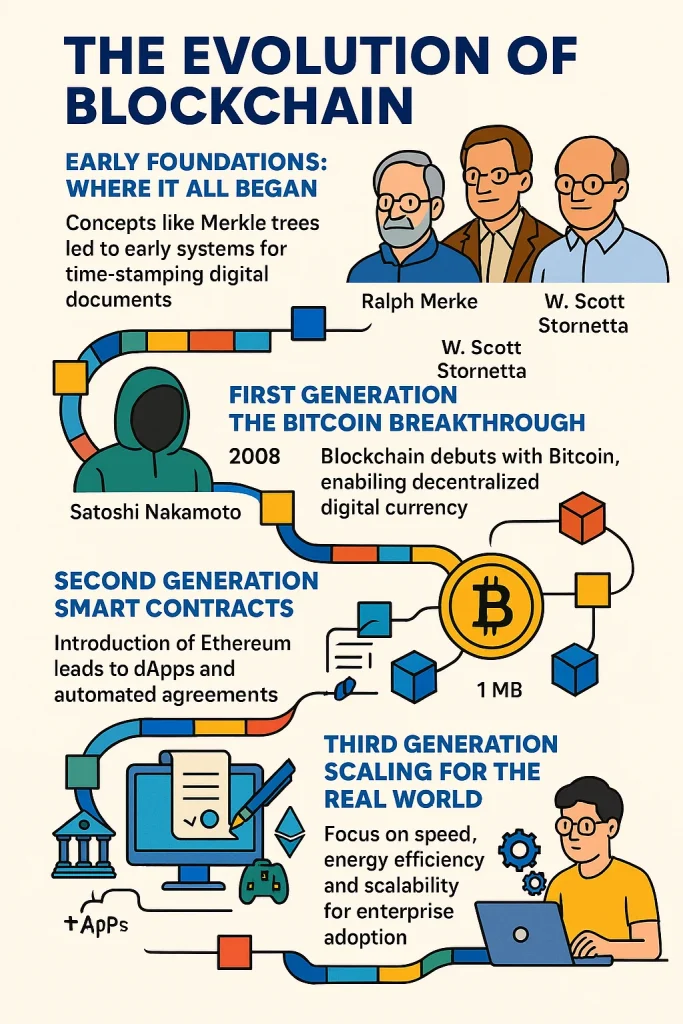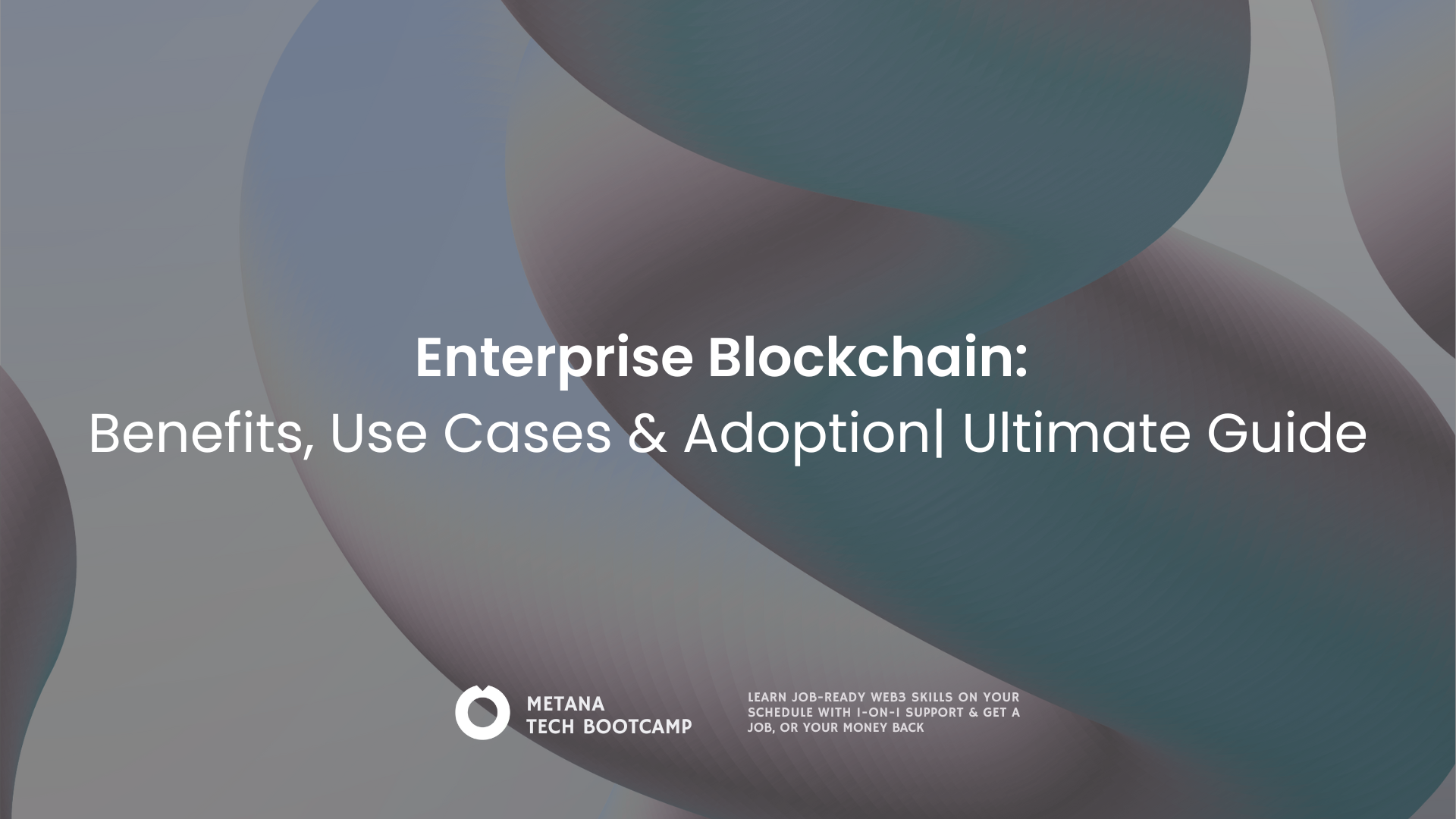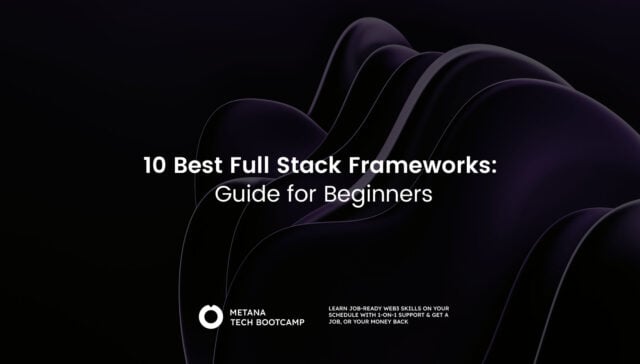TL; DR: Enterprise Blockchain – Key Highlights
- Enterprise blockchains are private, permissioned networks built for business use.
- They offer stronger security and control compared to public blockchains.
- Improve data integrity, transparency, and traceability across operations.
- Reduce costs and delays by removing intermediaries and enabling automation with smart contracts.
- Enhance compliance, auditability, and customer trust through immutable records.
- Enable new business models, faster transactions, and more efficient global trade.
- The market is growing rapidly, expected to reach $145.9 billion by 2030.
Blockchain adoption is not just a trend; it’s a strategic move. Companies are leveraging it to gain a competitive edge.
What is Blockchain Technology?
By its definition, blockchain technology functions as a decentralized network where multiple users can collectively manage and update a digital record. Without needing a central governing body, it ensures transactions are permanently and securely stored, offering reliable solutions for numerous industries and real-world applications.
Afterall, blockchain technology with its advancements combined with AI is used in a range of fields. It goes beyond the purpose of securing decentralized payments and financial transactions through cryptocurrencies like Bitcoin and Ethereum.
One of the best use cases of this technology is in healthcare, where projects like MIT’s MedRec use blockchain to securely manage and share electronic health records (EHRs), giving patients control over their data, while ensuring privacy, transparency, and data integrity.
Now, let’s get into what enterprise blockchain technology really is!
What is Enterprise Blockchain Technology?
Enterprise blockchain is a tailored blockchain for businesses. Unlike public blockchains, it restricts access to authorized users only. Meaning, if you are an outsider, you will have no access at all! It serves as a shared ledger system. Multiple parties can collaborate securely.
Enterprise blockchain is usually a:
→ Private Blockchain (if managed by one organization)
→ Consortium Blockchain (if managed by a group of organizations)
“Public Blockchains are completely open and decentralized. Yep, like Bitcoin and ethereum!” These will offer you the highest level of decentralization. Yet, comes out with a cost of speed and high-energy consumption.
Never too late to get brainstormed with the different types of blockchain!
Evolution of Enterprise blockchain
Here’s a short trip through history you might find interesting:

1. Early Foundations: Where It All Began
Blockchain didn’t just pop up overnight. Its roots actually go back to the late 1970s, when a guy named Ralph Merkle came up with a way to link digital data securely. Yep, what we now call Merkle trees. It was a technical idea, but it laid the groundwork for something much bigger.
Fast forward to the 1990s, and two researchers, Stuart Haber and W. Scott Stornetta, used that concept to build a system that could time-stamp digital documents. The goal? Make sure no one could tamper with important records after they were created. It was one of the first real steps toward what we now think of as blockchain.
And here’s to you for a spark of interest: World leaders in Cryptography
2. First Generation: The Bitcoin Breakthrough (2008)
In 2008, blockchain made its modern debut when Satoshi Nakamoto released the Bitcoin white paper. This was the first time blockchain was used to support a decentralized currency. The network allowed people to send and receive Bitcoin without needing a central authority, using 1 MB blocks to record transactions.
3. Second Generation: Smart Contracts
Blockchain’s potential didn’t stop at digital money. With the launch of Ethereum, the technology evolved into a platform for smart contracts…bits of code that could automatically execute agreements. This enabled new use cases like decentralized applications (dApps) and automated services in finance, gaming, and more.
In 2008, blockchain made its modern debut when Satoshi Nakamoto released the Bitcoin white paper. This was the first time blockchain was used to support a decentralized currency. The network allowed people to send and receive Bitcoin without needing a central authority, using 1 MB blocks to record transactions.
4. Third Generation: Scaling for the Real World
Today, blockchain is tackling bigger challenges: speed, energy efficiency, and scalability. This third phase is all about making blockchain viable for enterprise use. Businesses want systems that can handle high volumes, work faster, and integrate with real-world processes and developers are rising to the challenge.
Interested about the future? Read more about lightchain AI which is an advanced framework for lightweight blockchain powered AI infrastructure….
What are the key features of Enterprise Blockchain?
The following key features of enterprise blockchain makes it ideal for a business:
1. Permissioned Access
Enterprise blockchains operate on a permissioned model, meaning only authorized participants can access, validate, or contribute to the network. This ensures greater control and privacy.
2. Customizable Governance
Organizations can define their own rules for network participation, decision-making, and upgrades, giving them flexibility in managing the system.
3. Privacy with Transparency
While transactions are recorded on a shared ledger, sensitive business data can be restricted to certain participants, ensuring both accountability and confidentiality.
4. Interoperability
Enterprise blockchains are built to integrate with existing business systems (like ERP, CRM, and databases) and can interact with other blockchains to enhance utility.
5. Auditability and Traceability
All transactions are recorded in an immutable ledger, providing full visibility for audits, compliance, and traceability across the supply chain or business process.
Closing the knowledge loop:
Enterprise blockchain platforms like Oracle Blockchain bring these key features to life in real-world business environments.
Oracle Blockchain Platform is a permissioned blockchain solution tailored for enterprises. It offers:
- Fine-grained access control for secure participation
- Built-in smart contract support to automate processes
- Integration tools that connect easily with existing business systems like ERP or supply chain platforms
- High performance and scalability designed for enterprise-grade transaction volumes
To explore how a leading enterprise platform puts these features into action, read more about Oracle Blockchain Platform.
11 reasons enterprises are adopting blockchain technology
Key benefits of Enterprise Blockchain
Enterprises see blockchain as a game-changer. Its promise of enhanced data security is appealing. The technology reduces the risk of tampering and fraud. Blockchain also brings transparency and traceability. Businesses can track transactions and goods through a decentralized system. This leads to improved accountability and trust.
1. Enhanced data security and integrity
Enterprise blockchain technology enhances data security through its core features. Cryptographic encryption keeps information safe from unauthorized access. This improves data integrity, making tampering more difficult.
The decentralized nature of blockchain adds another layer of protection. Data is not stored in a single location, reducing vulnerability. This decentralization ensures a higher level of security for enterprises.
Key benefits include:
- Strong cryptographic encryption
- Decentralized data storage
- Reduced risk of data breaches
As businesses prioritize data security, blockchain offers a reliable solution. Enterprises benefit from its robust protection mechanisms and gain peace of mind.
Encryption and decryption are the backbones of cryptography, thus securing confidentiality of your business data (Source: private vs public key encryption)
2. Improved transparency and traceability
Enterprise blockchain offers significant improvements in transparency and traceability. It provides a clear, unchangeable record of transactions.
This makes it easier to track products and verify their origins. Businesses can reduce fraud and errors with blockchain technology. By ensuring every step of a process is logged, companies gain better oversight. This level of traceability helps build trust with consumers and partners alike.
Benefits include:
- Verifiable transaction records
- Reduced potential for fraud
- Enhanced product tracking
Integrating blockchain into supply chains fosters accountability and authenticity. These improvements benefit both businesses and their customers.
3. Streamlined operations and cost efficiency
Enterprise blockchain can streamline operations, leading to cost efficiency. It reduces the need for intermediaries in transactions, cutting costs. Businesses can process transactions more quickly and with less expense.
By automating processes, enterprises minimize human intervention. This decreases errors and administrative overhead. As a result, operations become more effective and aligned with business goals.
Key advantages include:
- Lowered transaction costs
- Reduced reliance on middlemen
- Optimized business processes
Ultimately, blockchain technology transforms how companies manage resources. This leads to increased profitability and competitive advantage.
4. Automation with smart contracts
Smart contracts automate tasks that were once manual, reducing the risk of error. These self-executing contracts handle transactions with precision. They enforce agreements automatically when conditions are met.
This automation not only saves time but ensures consistency. Enterprises benefit from increased reliability in their operations. The need for manual oversight decreases, enhancing efficiency.
Notable benefits of smart contracts include:
- Reduced administrative workload
- Increased transaction accuracy
- Enhanced operational reliability
By adopting smart contracts, businesses streamline processes and focus on core activities, improving overall effectiveness.
5. Faster transaction processing and settlement
Enterprise blockchain accelerates transaction times significantly. Traditional methods often involve slow, multi-step processes. Blockchain simplifies this with immediate, peer-to-peer transfers.
This speed ensures quicker access to funds and assets. Businesses experience fewer delays, enhancing cash flow management. This efficiency is crucial in industries demanding rapid transactions.
Key advantages include:
- Immediate transaction confirmation
- Streamlined clearing and settlement
- Reduced processing costs
Faster processing not only improves satisfaction but also reduces operational costs. Enterprises benefit from streamlined services, fostering competitiveness in dynamic markets.
6. Strengthened compliance and auditability
Enterprise blockchain enhances compliance by providing immutable records. This ensures data integrity and simplifies auditing processes. Regulatory compliance becomes seamless with accurate, traceable data trails.
Auditors benefit from real-time access to these records. This reduces the time and resources needed for compliance checks. Blockchain’s transparency assures regulators of record accuracy.
Benefits of strengthened compliance include:
- Simplified audit processes
- Reduced compliance costs
- Enhanced trust with regulators
By streamlining regulatory processes, enterprises can focus on growth. Blockchain ensures that compliance efforts remain efficient and effective, creating a trustworthy business environment.
7. Greater collaboration and data sharing
Enterprise blockchain facilitates collaboration by providing a unified, secure platform for data exchange. It enables organizations to share information efficiently, ensuring data consistency and accuracy.
Through shared ledgers, enterprises can build trust in their partnerships. This trust is crucial in collaborative environments, where data must be reliable and accessible to all stakeholders.
Benefits of greater collaboration and data sharing include:
- Improved coordination between partners
- Increased innovation opportunities
- Reduction of information silos
By enhancing data collaboration, blockchain supports strategic partnerships and creates synergy in business ecosystems. This fosters mutual growth and competitive advantage.
8. Enhanced customer trust and product provenance
Consumers today demand transparency regarding the origins of their products. Enterprise blockchain addresses this by providing verifiable records of product history. Customers gain confidence knowing the product’s journey, from raw material to delivery.
Blockchain ensures the authenticity of provenance, reducing counterfeiting and fraud. This heightened transparency strengthens brand loyalty and customer satisfaction.
Key benefits of enhanced provenance include:
- Increased brand credibility
- Assurance of ethical sourcing
- Reduced risk of counterfeit goods
Through blockchain, brands can offer a truthful, traceable path from creation to consumer, bolstering trust in the competitive marketplace.
9. Support for new business models and revenue streams
Enterprise blockchain is paving the way for innovative business models. By leveraging decentralized systems, companies can explore fresh revenue streams. These new opportunities often center around blockchain’s transparent and immutable nature.
Tokenization is a prime example where blockchain enables new financial instruments. It unlocks liquidity in traditionally illiquid assets, like real estate or fine art.
Advantages of new models include:
- Access to untapped markets
- Greater financial inclusivity
- Enhanced asset liquidity
Through blockchain, enterprises can redefine their business strategies, tapping into unexplored possibilities that traditional approaches overlook.
10. Increased supply chain resilience and efficiency
Supply chains benefit significantly from blockchain technology. It provides real-time data visibility and eliminates inefficiencies. With blockchain, transparency in tracking goods is enhanced, reducing disruptions.
The decentralized ledger records every transaction. This allows for improved monitoring of products from origin to destination. It minimizes errors and delays.
Key supply chain benefits from blockchain include:
- Real-time tracking
- Reduced fraud risk
- Enhanced coordination among stakeholders
Blockchain boosts supply chain resilience by improving efficiency and accountability, ultimately ensuring smoother operations.
Learn how blockchain works in different industries and how they transform the future.
11. Facilitation of cross-border transactions
Blockchain’s decentralized nature simplifies cross-border transactions. It offers reduced fees and increased processing speed. This makes international trade more efficient.
Traditional methods often require numerous intermediaries. Blockchain removes these barriers, ensuring smoother operations. Companies can conduct transactions swiftly and securely.
Key benefits include:
- Reduced transaction costs
- Enhanced transaction speed
- Increased transparency
Implementing blockchain in cross-border transactions not only lowers costs but also enhances reliability, making it a game-changer for global trade. This results in a seamless and trustworthy experience for all parties involved.
Key considerations for enterprise blockchain adoption
Adopting blockchain technology involves careful planning. Enterprises must address scalability and interoperability. These factors can impact the system’s efficiency.
Legal and regulatory compliance is crucial. Organizations need to ensure blockchain solutions meet industry standards. Without compliance, risks can increase significantly.
Key considerations include:
- Scalability and interoperability challenges
- Regulatory compliance requirements
- Security and privacy measures
Blockchain’s success relies heavily on these considerations. Proper strategy and execution can mitigate potential pitfalls. Enterprises need to embrace these factors for effective blockchain.
Read more about blockchain and fintech and know how blockchain and fintech merge: Blockchain and fintech: the future of finance
The future of enterprise blockchain development
The enterprise blockchain market was worth about $9.64 billion in 2023, and it’s growing fast! By 2030, it’s expected to hit around $145.9 billion, with a strong annual growth rate of 47.4% from 2024 to 2030.
North America is projected to lead the enterprise blockchain market, holding the largest share and maintaining its dominance throughout the forecast period. This strong position is mainly due to the widespread adoption of blockchain technology across key sectors such as banking and finance (BFSI), government, and healthcare.
This information was taken from Next Move Strategy Consulting Enterprise blockchain report.
Finally: Start Your Blockchain Journey Today
Enterprise blockchain is changing how industries operate, creating new opportunities for innovation, security, and trust. As more companies adopt this technology, the demand for skilled professionals is growing fast.
If you’re ready to explore this exciting space, a practical and focused learning path can make all the difference.
The Web3 bootcamp from Metana is designed to help you gain real-world skills through practical learning and expert guidance. It is built for those who want to learn by doing and prepare for a future in blockchain.
Take the first step. Learn blockchain. Build your future.
Frequently Asked Questions
What are the 4 types of blockchain?
Four different types of blockchains are public blockchain, private blockchain, consortium blockchain and hybrid blockchains.
Does Google use Blockchain?
Yes. Google uses blockchain node engine to enhance expertise, reliability and security in web3.
What is the difference between enterprise blockchain and public blockchain?
Enterprise blockchains are private and used by trusted participants within an organization or group. Public blockchains are open to anyone, and the identities of validators are usually unknown. This makes public blockchains more vulnerable to risks like a 51 percent attack, where one group controls most of the network. In enterprise blockchains, the validators are known and trusted, so this kind of risk is much lower.








